Finding Concealed Water Line Leaks: 6 Clever Methods
Finding Concealed Water Line Leaks: 6 Clever Methods
Blog Article
What are your thoughts on Detecting hidden plumbing leaks?

Early detection of dripping water lines can alleviate a prospective calamity. In addition to saving you money, it will reduce the aggravation as well as stress. The minute you discover a leak, calling your plumber for repair services is the very best service. Nevertheless, some little water leaks might not be visible. If you can not find it with your naked eyes, here are some hacks that help.
1. Check Out the Water Meter
Every residence has a water meter. Examining it is a proven way that helps you find leakages. For beginners, turn off all the water sources. Ensure no person will purge, make use of the faucet, shower, run the cleaning device or dishwasher. From there, go to the meter and also watch if it will transform. Considering that no person is using it, there must be no motions. That shows a fast-moving leak if it moves. Furthermore, if you spot no changes, wait an hour or more and also check back again. This suggests you might have a slow-moving leakage that could even be below ground.
2. Check Water Intake
Evaluate your water bills and track your water consumption. As the one paying it, you must notice if there are any type of discrepancies. If you find sudden changes, regardless of your consumption coinciding, it means that you have leaks in your plumbing system. Bear in mind, your water bill ought to drop under the very same array monthly. An abrupt spike in your bill indicates a fast-moving leak.
Meanwhile, a stable increase each month, despite the exact same habits, reveals you have a slow-moving leakage that's likewise slowly rising. Call a plumber to completely check your home, especially if you feel a cozy location on your floor with piping below.
3. Do a Food Coloring Examination
When it pertains to water consumption, 30% comes from commodes. Test to see if they are running appropriately. Decline flecks of food color in the container and also wait 10 minutes. There's a leakage in between the tank and bowl if the shade somehow infiltrates your dish throughout that time without flushing.
4. Asses Exterior Lines
Don't neglect to examine your exterior water lines as well. Test faucets by attaching a yard hose pipe. Should water permeate out of the connection, you have a loosened rubber gasket. Replace this and also make certain all connections are limited. If you have actually got a lawn sprinkler, it will certainly help get it skillfully analyzed and also preserved each year. One tiny leak can squander tons of water as well as increase your water costs.
5. Evaluate the situation and also check
House owners must make it a practice to check under the sink counters and also even inside closets for any bad odor or mold and mildew growth. These 2 red flags show a leakage so prompt attention is needed. Doing regular evaluations, also bi-annually, can save you from a significant trouble.
Extra importantly, if you know your house is currently old, maintain a watchful eye on your heaters, pipes, pipes etc. Check for discolorations as well as compromising as the majority of devices and also pipelines have a life expectancy. They will certainly also normally deteriorate due to tear as well as put on. Don't wait for it to intensify if you think dripping water lines in your plumbing system. Call a specialist plumber today so you don't wind up with a horrible mess in your home.
Early detection of dripping water lines can mitigate a prospective calamity. Some tiny water leaks may not be visible. Inspecting it is a proven means that assists you uncover leakages. One small leak can lose bunches of water and also spike your water bill.
If you believe leaking water lines in your plumbing system, don't wait for it to intensify.
WARNING SIGNS OF WATER LEAKAGE BEHIND THE WALL
PERSISTENT MUSTY ODORS
As water slowly drips from a leaky pipe inside the wall, flooring and sheetrock stay damp and develop an odor similar to wet cardboard. It generates a musty smell that can help you find hidden leaks.
MOLD IN UNUSUAL AREAS
Mold usually grows in wet areas like kitchens, baths and laundry rooms. If you spot the stuff on walls or baseboards in other rooms of the house, it’s a good indicator of undetected water leaks.
STAINS THAT GROW
When mold thrives around a leaky pipe, it sometimes takes hold on the inside surface of the affected wall. A growing stain on otherwise clean sheetrock is often your sign of a hidden plumbing problem.
PEELING OR BUBBLING WALLPAPER / PAINT
This clue is easy to miss in rooms that don’t get much use. When you see wallpaper separating along seams or paint bubbling or flaking off the wall, blame sheetrock that stays wet because of an undetected leak.
BUCKLED CEILINGS AND STAINED FLOORS
If ceilings or floors in bathrooms, kitchens or laundry areas develop structural problems, don’t rule out constant damp inside the walls. Wet sheetrock can affect adjacent framing, flooring and ceilings.
https://www.servicemasterbyzaba.com/blog/how-to-detect-water-leakage-in-walls/

We had been shown that editorial on Hacks to detect leaks through someone on a different web address. Are you aware of anybody else who is very much interested in Detecting hidden plumbing leaks? Why not share it. Thanks for your time. Visit us again soon.
Reliable plumber? Dial! Report this page